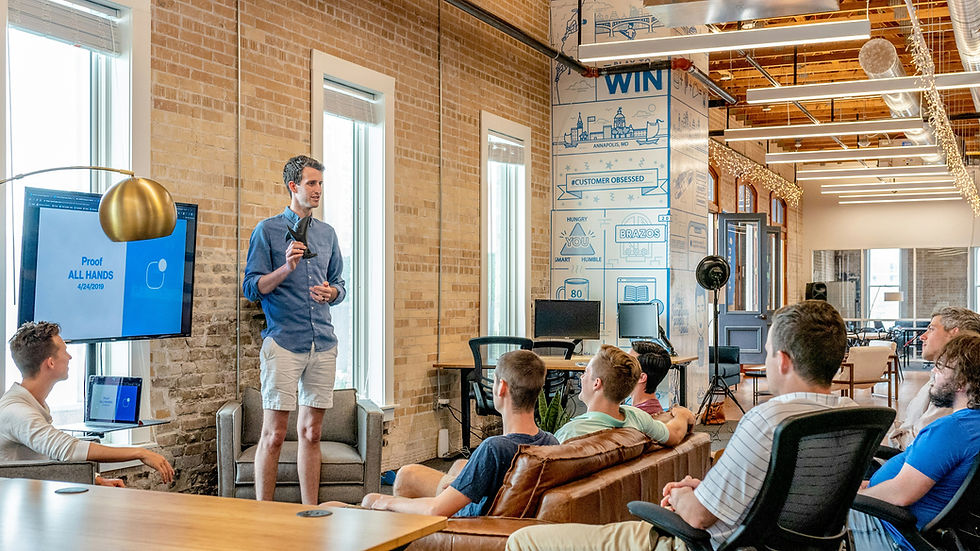Crafting the Future: Integrating Facilities Management to Elevate Workplace Experience and Employee Well-being
- Maxcene Crowe

- Oct 11, 2024
- 3 min read
A New Era for Facilities Management
In today’s rapidly changing work environment, Facilities Management (FM) is no longer just about making sure everything runs smoothly. It plays a key role in shaping how employees experience their workplace. Research shows that 73% of employees believe that a well-designed workplace directly influences their satisfaction at work. By focusing on employee well-being and productivity, organisations can enhance their overall performance and keep their talent engaged.
This article explores how Facilities Management can be a strategic asset. It will highlight specific ways FM can create workspaces that support and enhance the employee experience.

Understanding the Shift in Facilities Management
The definition of Facilities Management is evolving. Businesses understand that effective FM is linked to improved employee satisfaction and retention. 86% of organisations report a connection between workplace environment and employee engagement. Rather than merely maintaining facilities, FM professionals are now tasked with crafting invigorating spaces designed to boost productivity.
To succeed, FM professionals need skills that go beyond technical know-how. Understanding employee needs, workplace dynamics, and design principles is essential. Knowledge of ergonomics and environmental psychology equips them to create spaces where employees can thrive.
The Impact of Environment on Employee Well-being
A well-designed physical environment significantly influences employee well-being. For instance, studies show that access to natural light can improve mood and energy levels, which can lead to a 15% increase in productivity. Conversely, poor air quality can reduce focus and lead to health issues.
To create a workplace that encourages well-being, Facilities Management should focus on:
Incorporating natural elements: Adding plants can reduce stress and improve air quality, as evidenced by studies revealing that greenery can lower cortisol levels by 25%.
Optimising acoustics: Managing sound levels can enhance concentration and reduce fatigue.
Providing ergonomic furniture: Offering adjustable desks and supportive chairs can diminish discomfort, resulting in fewer sick days.
By observing how employees interact with their surroundings, FM can design spaces that cater to various needs, fostering a truly inclusive work atmosphere.
Promoting Collaboration and Community Through Design
The modern workplace thrives on collaboration. Facilities Management plays a crucial role in creating spaces that facilitate teamwork and community. Open floor plans, casual lounges, and designated breakout areas can foster connection, while also addressing the need for private, quiet spaces.
For example, implementing designated “focus rooms” can provide employees a retreat for deep work, which studies indicate can enhance productivity by 30%. By merging shared space with private areas, FM can promote both collaboration and individual focus, leading to happier employees and improved outcomes.
Enhancing Workplace Technology Integration
Technology is vital for revamping FM strategies. As companies adopt smart solutions, Facilities Management can elevate the workplace experience with innovative tools.
For instance:
Occupancy sensors can optimise workspace usage and enhance energy efficiency, saving organisations up to 30% on energy costs.
Mobile applications enabling employees to control their environment—like adjusting lighting or temperature—can substantially increase satisfaction.
With these technologies, Facilities Management transitions from maintenance to creating a proactive, engaging work environment.
Training and Development for FM Professionals
To effectively integrate FM with workplace experience, continuous professional development is essential. FM leaders should stay updated on emerging trends in workplace design and employee wellness. Training programs should cover:
Workplace psychology: Understanding human behaviour in work settings.
Organisational behaviour: Learning how culture influences work dynamics.
Design principles: Focusing on functional and aesthetic workplace layouts.
By investing in learning opportunities, organizations can ensure their FM teams are prepared to create environments that enhance employee well-being and productivity.
Crafting a New Future for Workspaces
As we move forward, it is evident that Facilities Management is becoming increasingly vital to workplace success. By prioritising employee experience and well-being, FM can become a cornerstone of strategic organisational success.
Investing in workplace design leads to not just satisfied employees, but thriving businesses. This evolution requires a mindset shift—embracing collaboration, innovation, and a commitment to human well-being.
When organisations prioritise facilities management with the goal of enhancing workplace experiences, they invest in their most precious resource: their employees. The future of Facilities Management is not just a trend; it’s a necessity for progress in the modern workplace.
.png)



Comments